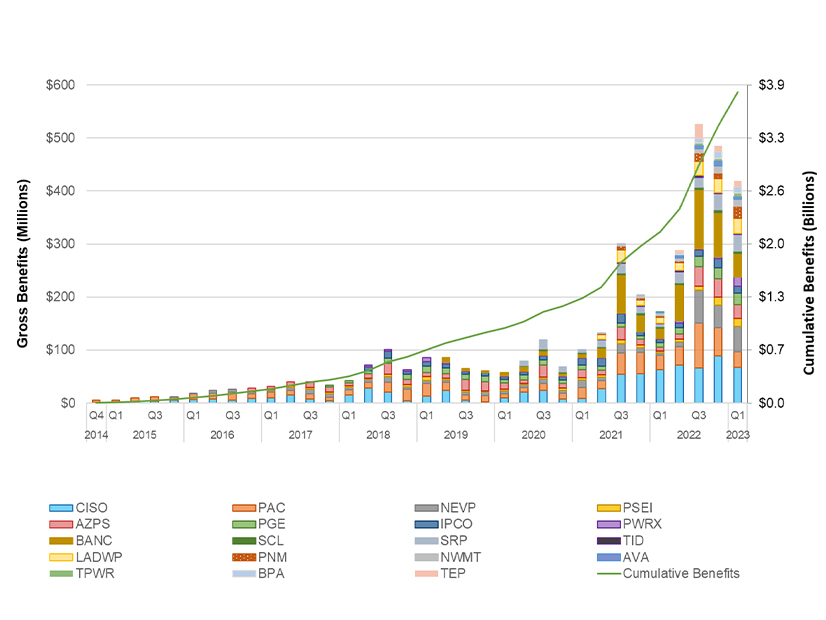CAISO’s Western Energy Imbalance Market yielded members $418.82 million in economic benefits during the first three months of 2023, up 143% from the same period in 2022 and a first-quarter record.
Cumulative benefits since the 2014 rollout of the market have nearly doubled over the past year, reaching $3.82 billion after three consecutive quarters that smashed records, according to CAISO’s first-quarter benefits report, released Thursday.
The sharp growth comes after four new participants entered the market last year: Avista Utilities, Tacoma Power, Tucson Electric Power and, most significantly, the Bonneville Power Administration, which operates 15,000 miles of high-voltage transmission — about 70% of the network in the Northwest.
The first-quarter benefits report was released about a month later than normal, which the ISO attributed to the need for more time “to review the benefits estimates and the underlying congestion observed in certain areas of the WEIM footprint,” according to a press release accompanying the report.
“Ultimately, no changes to the current methodology have been implemented to estimate the first quarter benefits. The CAISO and its WEIM partners will continue to assess and determine if methodology enhancements are warranted based on various conditions of congestion,” the ISO said in the release.
CAISO itself earned the largest share of benefits during the quarter, at $67.86 million, followed by NV Energy ($47.19 million), Balancing Authority of Northern California — or BANC ($44.63 million), Salt River Project — or SRP ($31.38 million), PacifiCorp ($28.94 million), and Los Angeles Department of Water and Power ($27.99 million).
BANC’s balancing authority area includes the state’s second-largest municipal utility, Sacramento Municipal Utility District, as well as Modesto Irrigation District, the cities of Redding and Roseville, and the Western Area Power Administration’s Sierra Nevada region.
CAISO was the largest net exporter of energy during the quarter, at 1,354,826 MWh, followed by SRP (510,350 MWh), NV Energy (478,330 MWh) and PNM (350,796 MWh). The ISO was also the second-largest net importer, at 848,513 MWh, exceeded only by British Columbia’s Powerex, at 881,791 MWh.
CAISO was also the location of the most wheel-through transfers, at 760,999 MWh, followed by Arizona Public Service (587,198 MWh), the PacifiCorp-West BAA (314,838 MWh) and NV Energy (296,657 MWh). In years past, NV Energy consistently handled the highest volume of wheel-throughs, but the inclusion of more Pacific Northwest WEIM participants appears to be shifting a greater share of those transfers to California. Market members gain no financial benefit from facilitating wheel-throughs, with only the sink and source directly benefiting.
CAISO said WEIM operations helped reduce renewable curtailments by 53,002 MWh during the first quarter, helping to prevent emission of 53,002 metric tons (MT) of CO2. The market has avoided 814,746 MT of carbon emissions since 2015, the ISO estimates.
With the inclusion of the Western Area Power Administration–Desert Southwest region and Avangrid in April, the WEIM footprint now covers 79% of the load in the Western Interconnection. CAISO expects the market to break $4 billion in total benefits this quarter.




